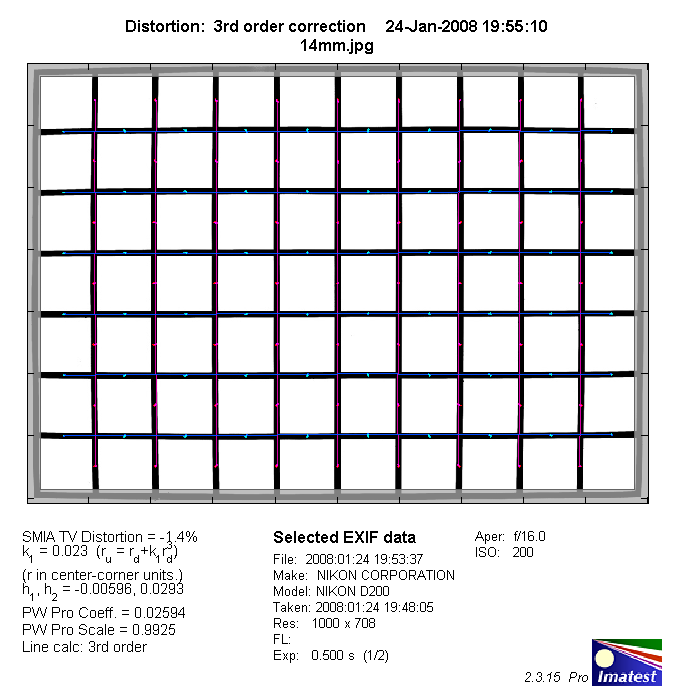|
Nikkor AF-S 14-24mm f/2.8 G ED N - Review / Test Report - Analysis |
|
Lens Reviews -
Nikon / Nikkor (APS-C)
|
|
Page 2 of 3
Distortion
Regarding its moderate 1.7x zoom ratio the AF-S 14-24mm f/2.8 may appear unambitious but it's still
an ultra-wide angle lens and these tend to produce a significant amount of barrel distortion. However,
against all odds the Nikkor does an exceptional job here. Technically a barrel distortion of 1.4% @ 14mm
may still be visible in a few situations but compared to similar lenses, especially in the APS-C league,
this is a very moderate figure. The problem is pretty much negligible at 18mm and more so at 24mm.
|
Move the mouse cursor over the focal length text marks below to observe the respective distortion
|
| 14mm |
18mm |
24mm |
|

|
The chart above has a real-world size of about 120x80cm.
Vignetting
The AF-S 14-24mm is a full format lens which enjoys the usual sweet spot advantage
when used on an APS-C DSLR. The vignetting figures are very low indeed and usually you
don't even have to worry about this issue at f/2.8. At f/4 vignetting is basically
non-existent in real world terms.

MTF (resolution)
Unlike most of the competition the Nikkor produced exceptionally high resolution
figures throughout the focal length range and across the image field. Surprisingly
the performance sweet spot is at the wide-end of the range. On the D200 the Nikkor
is basically diffraction-limited here. Reads: the peak resolution is already reached
at f/2.8 and only diffraction effects beyond f/5.6 are a limiting factor here. It is
quite safe to state that the lens has a resolution potential beyond the 10mp sensor
of the test camera. This is truly stunning and unprecedented in this range especially
because the borders and even the extreme corners are only marginally worse than the
center. There's a marginal resolution penalty at 18mm and 24mm but it's unlikely that
you will notice this in field conditions. Another nice aspect is the marginal degree
of field curvature which is often a relevant issue with other lenses.
Please note that the MTF results are not directly comparable across the different systems!
Below is a simplified summary of the formal findings. The chart shows line widths per picture height (LW/PH) which can be taken as a measure for sharpness.
If you want to know more about the MTF50 figures you may check out the corresponding Imatest Explanations
Chromatic Aberrations (CAs)
Lateral chromatic aberrations (color shadows at harsh contrast transitions) are
very well controlled even at 14mm. At around 1px on the average at the image borders you
may be able to spot the problem at times. However, when putting this figure into
perspective vs the competition again this is just exceptional. If the lateral
CAs are a bothering factor for you Nikon Capture NX will be able to care about the
problem instantly. At 18mm and more so at 24mm this is even a lesser problem.

Flare
So far everything looks just amazing, doesn't it, but the lens has also a weakness (or two).
Some users complained about flare problems in contra light situations and yes,
I would concur here. Before digging deeper I should note that ultra-wide angle lenses
are never free of flare and ghosting problems. Despite all marketing claims by
the manufacturers it is always possible to force a lens into flaring and even Nikon's
new fancy Nano Crystal Coat will not make it an exception to the rule. That all
said in advance you may check out some flare samples below.
The first two images are just web-sized, the third one is a crop.
Click on the image to enlarge:

Ok, the first image is a bit unfair to start with. It was taken straight into the sun.
The vast majority of lenses would produce flare here and it just shows that the Nikkor
is no different. The 2nd image is similar although I didn't really intend to
produce the effect here. You may notice the glare rings here to the lower right hand
side. The third image is a bit more ugly - there was no light source whatsoever within
the image field here. As mentioned the Nikkor has a very protruding front element and
it "collected" streaking light from the side here which produced this fairly
obvious rainbow effect.
Let's have a look at some sample images now ...
|